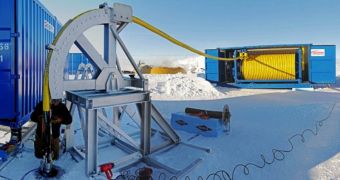A team of experts from the University of Bristol, in the UK, led by glaciologist Martin Siegert, recently published the conclusions of a new analysis on why an expedition to drill through the Antarctic ice sheet in order to reach a lake buried deep underneath failed in late 2012.
The expedition was meant to reach Lake Ellsworth, a submerged lake in western Antarctica that was encapsulated by encroaching ices some 30 million years ago. This body of water may still contain descendants of simple lifeforms that lived in our planet's distant past.
The drilling project was carried out a year ago using a $12 million (€8.85 million) grant from the UK Natural Environment Research Council (NERC). On December 25, 2012, the University of Bristol team had to abandon the drilling project, due to equipment failure and other technical difficulties.
The issues began weeks before the initiative was discontinued, but the team hot-fixed many of the problems before they became insurmountable. The group has now published its conclusions on what went wrong, and highlighted the steps needed to ensure that future expeditions are successful.
For the early December 2012 expedition, Siegert and his group used a hot-water drilling technique developed by researchers at the British Antarctic Survey (BAS). The team was hoping to pierce through 3-kilometer (1.4-mile) thick ices within 72 hours, but the drill bits were unable to rise to the challenge.
Their paper is currently being reviewed by the journal Annals of Glaciology for publishing. The study indicates that it may be possible to improve the equipment used for Antarctic drilling, but adds that a few years of engineering work is needed to achieve this goal, Nature News reports.
“I am glad to see that they plan to publish their drilling efforts. It will quell rumors and provide a solid bit of groundwork on which they can move forward,” comments Montana State University glaciologist John Priscu, who was also involved in similar drilling projects near the South Pole.
The Ellsworth project and others like it are important because they can reveal more clues about what researchers could expect to find under the miles-thick ice crusts covering alien environments, such as on Enceladus, Ganymede and Europa, all moons of Jupiter and Saturn.
“Antarctic science is by its nature risky. However, the potential gains in knowledge outweigh the costs and the risks in most cases, and this is especially true for the exploration of subglacial aquatic environments,” concludes the chair of the Lake Ellsworth advisory committee, Mahlon Kennicutt.

 14 DAY TRIAL //
14 DAY TRIAL //